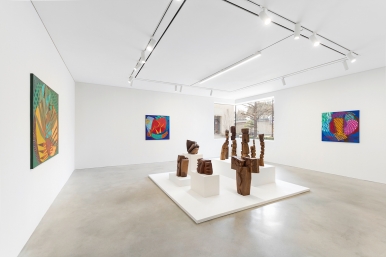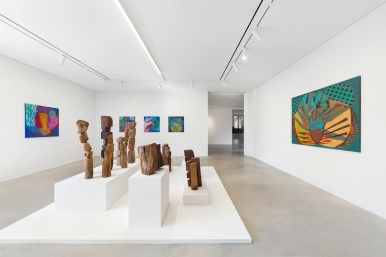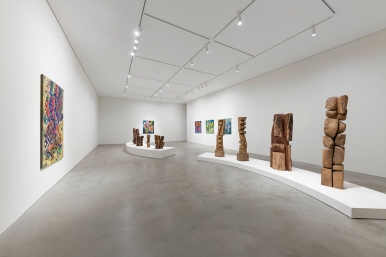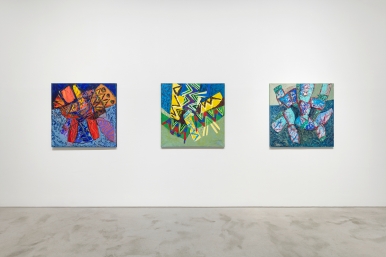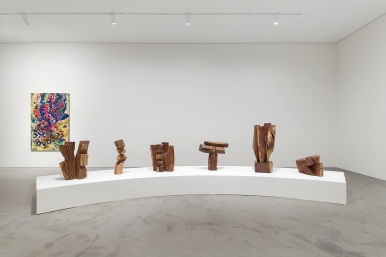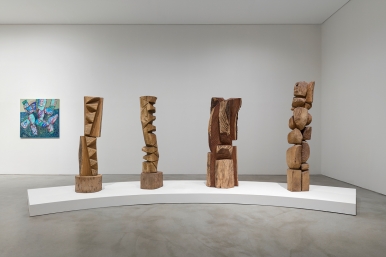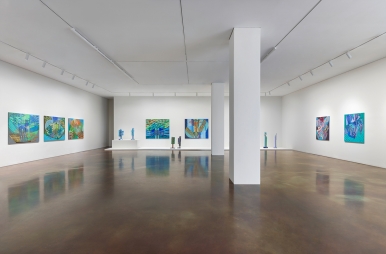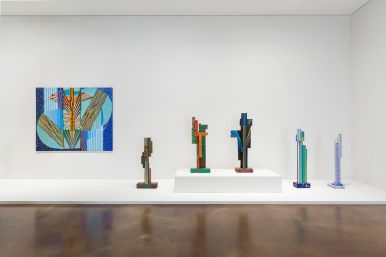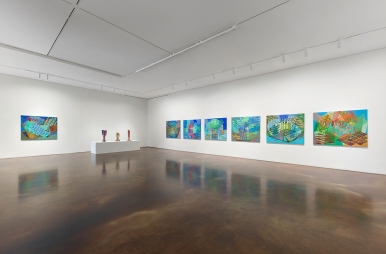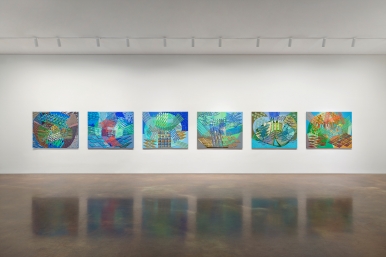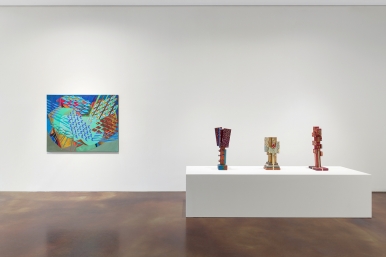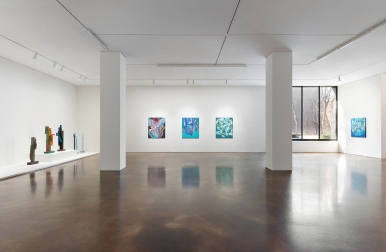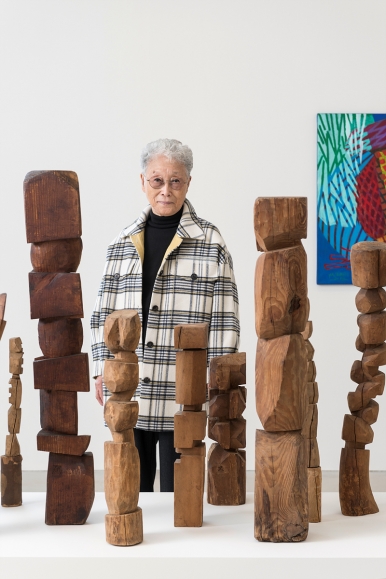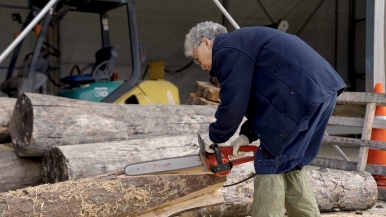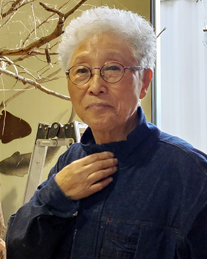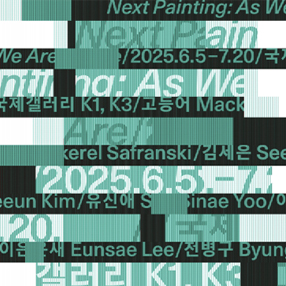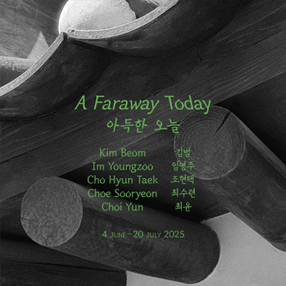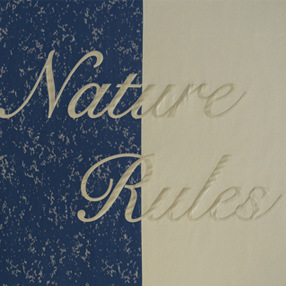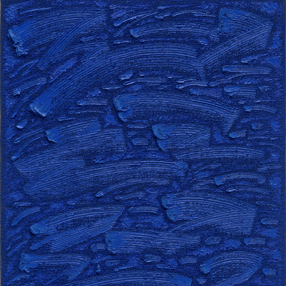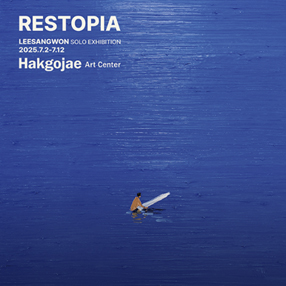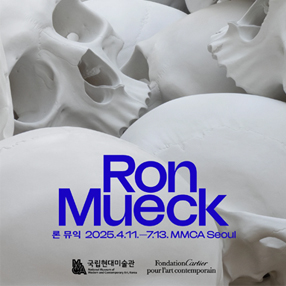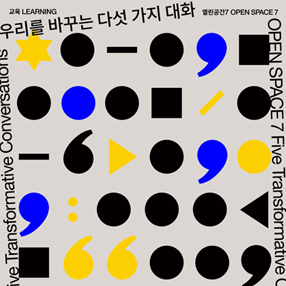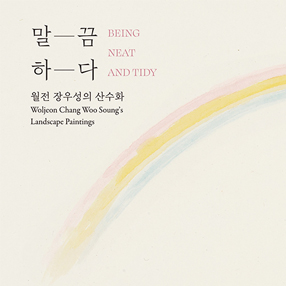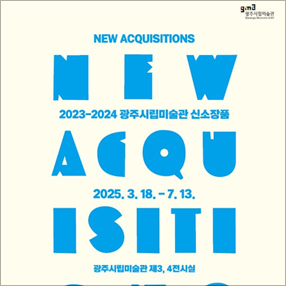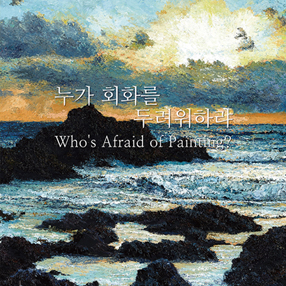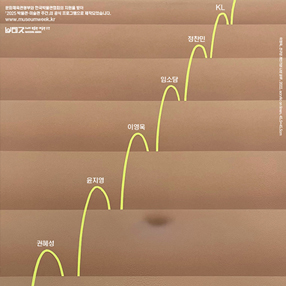본문
-
김윤신
《Kim Yun Shin》 설치전경 이미지 제공: 국제갤러리
-
김윤신
《Kim Yun Shin》 설치전경 이미지 제공: 국제갤러리
-
김윤신
《Kim Yun Shin》 설치전경 이미지 제공: 국제갤러리
-
김윤신
《Kim Yun Shin》 설치전경 이미지 제공: 국제갤러리
-
김윤신
《Kim Yun Shin》 설치전경 이미지 제공: 국제갤러리
-
김윤신
《Kim Yun Shin》 설치전경 이미지 제공: 국제갤러리
-
김윤신
《Kim Yun Shin》 설치전경 이미지 제공: 국제갤러리
-
김윤신
《Kim Yun Shin》 설치전경 이미지 제공: 국제갤러리
-
김윤신
《Kim Yun Shin》 설치전경 이미지 제공: 국제갤러리
-
김윤신
《Kim Yun Shin》 설치전경 이미지 제공: 국제갤러리
-
김윤신
《Kim Yun Shin》 설치전경 이미지 제공: 국제갤러리
-
김윤신
《Kim Yun Shin》 설치전경 이미지 제공: 국제갤러리
-
김윤신
김윤신 작가 프로필 이미지 사진: 안천호 이미지 제공: 국제갤러리
-
김윤신
김윤신 작가 Studio Visit 영상 제공: 국제갤러리
-
Press Release
“합(合)과 분(分)은 동양철학의 원천이며 세상이 존재하는 근본이다. 나는 1975년부터 그런 철학적 개념을 추구해오고 있고, 그래서 나의 작품에 ‘합이합일 분이분일(合二合一 分二 分一)’이라는 제목을 붙였다. 이는 두 개체가 하나로 만나며, 다시 둘로 나누어진다는 의미다. 그리고 인간의 존재에서처럼 계속적으로 무한대적으로 합과 분이 반복된다. [...] 전기톱을 사용하여 분에 의하여 창조된 선과 면은 합이요 동시에 분이다. 나의 정신, 나의 존재, 그리고 나의 영혼은 하나가 된다. 절대자로부터 축복받은 존재이길 염원하면서.” – 김윤신
국제갤러리는 오는 3월 19일부터 4월 28일까지 김윤신의 개인전 《Kim Yun Shin》을 개최한다. 1980년대 중반 남미로의 이주를 통해 한국의 주류 모더니즘에서 물리적으로 단절된 채 자신만의 독자적인 시각문법을 구축한 김윤신은 재료의 물성, 특히 나무 고유의 성정을 존중하며 탐구해왔다. 아르헨티나로 이주해 그곳에서 40년을 뿌리내렸던 그가 한국으로 거점을 옮겨 꾸리는 첫번째 전시이자 국제갤러리와의 첫 프로젝트에서 작가는 1970년대부터 작품세계를 관통하는 ‘합이합일 분이분일’의 철학에 기반한 목조각 연작과 함께 꾸준히 지속해온 회화 작업 등 총 50여 점의 작품을 K1과 K2에 걸쳐 선보인다.
1970년대 중후반부터 시작된 〈합이합일 분이분일〉은 김윤신의 조각 전반을 아우르고 있는 작품의 제목이다. 둘을 합하여도 하나가 되고, 둘을 나누어도 하나가 된다는 이 우주적인 문구는 작가에게 작업의 근간이 되는 철학이자 삶의 태도이다. 서로 다른 둘이 만나 상호작용을 통해 하나가 되고, 그렇게 만난 합이 다시 둘로 나뉘어 각각의 또 다른 하나가 되는 역학의 반복은 곧 작가가 작업하는 과정을 묘사하는 것이기도 하다. 그의 작업은 자신 앞에 주어진 재료를 관조하는 것으로부터 시작되는데, 눈 앞의 나무를 오랜 시간 바라보며 그 대상과 충분한 대화를 나누다 한 순간 전기톱을 들고 거침없이 나무를 잘라 나간다. 이렇게 조각의 재료인 나무와 작가가 하나가 되며 합(合)을 이루고, 그러한 합치의 과정은 나무의 단면을 쪼개 새로운 공간을 만들어가는 여러 분(分)의 단계들로 이루어지며, 그 결과물로서 비로소 또 하나의 진정한 분(分), 즉 작품이 탄생하게 된다.
K1에서는 〈합이합일 분이분일〉의 근원이 되는 1970년대 작 〈기원쌓기〉를 시작으로 현재까지 작가가 꾸준히 매진해온 원목 조각들과 함께 회화 작업의 일부가 소개된다. 인간과 자연의 관계를 고찰하며 초월적 존재에 닿고자 하는 염원의 정서는 일찍이 그의 초기 작업에서부터 엿볼 수 있는 특징이다. 초창기 전통에 대한 (재)해석에 유독 관심을 보이기도 한 그는 민간신앙 속 장승의 모습이나 돌 쌓기 풍습 등의 토템에 영향을 받아 나무를 수직적으로 쌓아 올렸고, 그에 대한 형식적 변주는 자연스레 〈합이합일 분이분일〉 연작에 이르게 되었다. 알가로보 나무, 라파초 나무, 칼덴 나무, 유창목, 케브라초 나무, 올리브 나무 등 다양한 원목이 그의 손을 거쳐 다채로운 형태의 ‘기도’가 되는데, 특히 그의 톱질을 통해 드러나는 나무의 속살과 원래의 모습 그대로 살려둔 나무의 거친 껍질이 이루는 시각적 대조는 김윤신 조각의 대표적인 표현적 특징으로 자리잡았다.
K2에서는 아르헨티나의 대지, 그 특유의 에너지와 생명력을 연상시키는 회화와 회화 조각을 대거 선보인다. 작가는 “그림을 해야 조각을 하고, 조각을 함으로써 그림을 그릴 수 있다”고 설명하며 조각과 회화를 떼려야 뗄 수 없는 관계라 규정한다. 조각과 일맥상통하며 표면의 분할을 특징으로 하는 김윤신의 회화는 남미의 토속색과 한국의 오방색에서 영감 받은 원색의 색감으로 제작되는가 하면, 멕시코 여행을 계기로 아스테카의 흔적을 입기도 하는 등 작가의 환경과 심경을 적극적으로 반영한다. 〈이루어지다〉, 〈내 영혼의 노래〉, 〈원초적 생명력〉, 〈기억의 조각들〉, 〈진동〉 등의 제목으로 진행되는 회화 작업은 나이프로 물감을 긁는 기법으로 원시적 에너지를 표출하거나, 물감을 묻힌 얇은 나무 조각을 하나하나 찍어내 구사한 다양한 색상의 선과 자유분방한 면을 통해 강인한 생명력의 본질 및 삶의 나눔을 찬양한다.
회화와 조각을 아우르는 김윤신의 시각적 문법은 자연스레 목조각에 채색을 시도하는 방식으로 이어졌다. 남미의 토테미즘에서 한국 전통 색상 및 패턴의 유사성을 발견한 작가는 조각을 색조 및 기하학 실험의 장으로 삼기도 했다. 나아가 작가가 ‘회화 조각’이라 명명한 이 유형의 조각군은 전지구적 팬데믹 시기를 맞아 더욱 적극적으로 제작, 변주되기에 이른다. 당시 한 개인으로서 여러 일상 속 규제를 당면한 한편 예술가로서도 좋은 재료를 구하는 것이 힘들어지자, 작가는 일상 주변의 나무 조각들을 모아 작업하는 새로운 방식에 몰두했다. 이렇듯 목재 파편 내지 폐목을 재활용해 자르고 붙여 색을 입힌 회화 조각은 회화와 조각을 잇고 나누는 또 하나의 ‘합이합일 분이분일’을 보여준다. 생을 관통하여 매 순간 도약해온 김윤신의 우주는 열린 마음으로 재료와 기법을 탐구하는 실험 및 도전정신을 통해 조각과 회화, 그리고 회화 조각이라는 영역으로 여전히 확장해 나가고 있다.
The principles of addition (合) and division (分) are the source of Eastern philosophy and the foundation on which the world exists. I have been pursuing this philosophy since 1975 and titled my work ‘Add Two Add One, Divide Two Divide One (合二 合一 分二 分一).’ In this dynamic, two entities come together and form a union as one, and this union becomes divided into two again. And then, as in the case of human existence, the process of addition and division are repeated continually and infinitely. [...] The lines and planes created by my chainsaw based on the process of division are, in this view, at once an addition and a division. My mind, my existence, and my soul become a unified one. At this instant, I pray that I may be the one blessed by the Absolute. – Kim Yun Shin
Kukje Gallery is pleased to present Kim Yun Shin, a solo exhibition by the Korean sculptor Kim Yun Shin, on view from March 19 to April 28, 2024. Since relocating to South America in the mid-1980s, Kim has forged an independent path as an artist, developing a singular visual language that bridges her experience as a woman artist and ex-patriot while also highlighting her unique position vis-à-vis mainstream Modernism in Korea from which she remained physically and conceptually separated. Driven by a keen interest in and respect for natural materials, she has especially dedicated herself to exploring the inherent properties of wood with a profound respect for its materiality. As the gallery’s first project with the artist, this exhibition also marks the first presentation of Kim’s work since her recent move back to Korea, her homeland, after having lived in Argentina for almost four decades. Taking place across K1 and K2, the exhibition highlights approximately 50 works by the artist, including wood sculptures based on her unique philosophy of “Add Two Add One, Divide Two Divide One (合二合一 分二分一),” a central concept that has guided her artistic practice since the 1970s. The exhibition will also include paintings that Kim has produced consistently over her prolific career.
Since the mid-1970s, Kim has organized her sculptural practice under the title of Add Two Add One, Divide Two Divide One, an expression that encompasses her sculptural practice. Based on the Eastern philosophy of Yin and Yang, this cosmic phrase conceived by Kim in the 1970s revolves around the interconnected dialectics of addition/integration and division/fragmentation. According to the artist, all matter in the universe can be described by the interchange in which two heterogeneous elements meet (“add two”) and become one through interaction (“add one”); this sum is then divided into two again (“divide two”) so each becomes one (“divide one”). This infinitely repeating dynamic not only forms the basis of her artistic philosophy and a way of life, but can also be applied to her sculptural process, which begins by observing the material for a long time with an intimate attention to the natural qualities of the found wood. Attuning her energies to the innate vital rhythm of her material, she takes her chainsaw to chip and carve away at the material based on the instinctual cue of the ‘right moment.’ Through an intuitive and labor-intensive approach, the wood and the artist become “one” and form a union (add 合); this process of union is then subject to multiple stages of fragmentation that involve dividing and creating space in the material (divide 分). As a result, the true “division” of the wood is rematerialized in the form of an artwork.
Assembled throughout K1 are wood sculptures mainly drawn from the ongoing series of Add Two Add One, Divide Two Divide One paired with paintings. Some of the persistent themes of her works, such as the quest for transcendence and a profound interest in the relationship between humans and nature, can be glimpsed in these early works. Stacking Wishes, for instance, is representative of her experiments with vertical stacking in the early and mid-1970s, which reflects her interest in (re)interpreting traditional motifs such as that of the Jangseung (a kind of traditional Korean totem) and the custom of stone stacking in Korean folk religion. Her formal variations on Stacking Wishes segued into Add Two Add One, Divide Two Divide One, as the former work is often regarded as a prototype of the latter. Passing through her hands, diverse types of raw wood—including algarrobo, lapacho, calden, eucalyptus, quebracho, and olive—get transformed into various forms of prayers. Notably, the visual contrast between the soft inner wood revealed through her sawing and the rough bark preserved in its original appearance has been recognized as a distinctive expressive feature in Kim’s sculptures.
On display in K2 are paintings and painted wood sculptures evocative of the unique vigor and dynamism of Argentina’s natural environment. In her definition of the inseparable relationship between sculpture and painting, Kim has said, “I need to paint in order to sculpt, and I need to sculpt in order to paint.” Her paintings, which share the formal characteristics of surface fragmentations observed in her sculptures, are charged with a vibrant palette consisting of colors and patterns drawn from Korean and South American indigenous traditions. Also visible are influences from her travels including Mayan and Aztec symbolism from Mexico, reflecting the way the artist has consistently synthesized cosmological vocabularies. Organized under titles such as Granted Wishes, Song of My Soul, Primal Vitality, Fragments of Memories, and Vibration, her paintings exude a sense of primitive energy accentuated by her rough-hewn techniques such as scraping the canvas with a palette knife to expose layers of paint or applying paint to thinly sliced pieces of wood and stamping them onto the canvas. Composed of multi-colored lines and free-floating planes, they celebrate the essence of vital force and virtue of life.
Kim’s visual grammar that straddles painting and sculpture naturally led her to an attempt at painting her wood sculptures. This group of painted sculptures became a field of experimentation with color and geometry for Kim, who was motivated into this direction after discovering an unexpected correspondence between premodern South American and Korean folk traditions and symbolic systems. Due to limited access to materials during the global pandemic, Kim has recently begun to focus on collecting pieces of wood available around her, a more organic approach that in turn has propelled her renewed interest in painting her sculptures. These new painted sculptures, comprising collaged, fragmented, and recycled wood covered with acrylic paint, illustrate another type of ‘Add Two Add One, Divide Two Divide One’ based on an integration and division of the two mediums of painting and sculpture. With her open-minded spirit and unflinching nature, Kim continues to expand her universe by fluidly moving between painting and sculpture, thereby reinvigorating the artistic potential of her chosen materials while remaining unafraid to take a leap, even at this precise moment.전시제목김윤신 《Kim Yun Shin》
전시기간2024.03.19(화) - 2024.04.28(일)
참여작가 김윤신
관람시간10:00am - 06:00pm / 일, 휴일 10:00am - 05:00pm
휴관일매주 월요일
장르회화, 조각
관람료무료
장소국제갤러리 Kukje Gallery (서울 종로구 소격동 58-1 K1, K2)
연락처02-733-8449
-
Artists in This Show
-
1935년 강원도 원산출생
-
국제갤러리(Kukje Gallery) Shows on Mu:umView All
Current Shows
-
서승원: The Interplay
PKM 갤러리
2025.06.05 ~ 2025.07.12
-
이상원 | Restopia
학고재 아트센터
2025.06.02 ~ 2025.07.12
-
론 뮤익 Ron Mueck
국립현대미술관
2025.04.11 ~ 2025.07.13
-
열린공간 7 《우리를 바꾸는 다섯 가지 대화》
국립현대미술관
2025.04.04 ~ 2025.07.13
-
말끔하다:월전 장우성의 산수화
이천시립월전미술관
2025.04.10 ~ 2025.07.13
-
2023-2024 광주시립미술관 신소장품
광주시립미술관
2025.03.18 ~ 2025.07.13
-
김남표: 누가 회화를 두려워하랴
성남큐브미술관
2025.05.16 ~ 2025.07.13
-
섬 프로젝트: Linking Island
아트센터 화이트블럭
2025.05.01 ~ 2025.07.13




